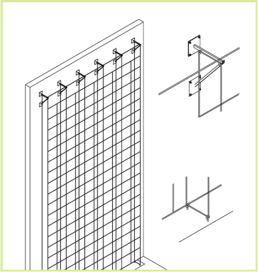UfU Information | Issue 4 – December 2021 | Department of Climate Protection and Transformative Education, Environmental Law & Participation
Aiming high together with FABIKLI!
Facade greening and biomass utilization for climate protection at schools
Together with the Technical University of Berlin (TUB), UfU wants to equip three Berlin schools with productive green facades in a pilot project and make a contribution to climate protection in schools with interactive workshops. The following article explains how it all works:
Potential of biomass use for climate protection
We refer to raw materials such as wood, maize, sunflowers, garden waste and waste from the organic waste garbage can as biomass. More precisely, the mass of organic matter in these raw materials. If this substance is used to generate energy, for example for district heating or biogas, it is referred to as bioenergy.

The advantage of biomass: only CO2 that was previously stored during growth is released during energy recovery. Unlike fossil fuels, there are no additional CO2 emissions. The carbon footprint of biomass is therefore CO2-neutral for the time being. However, the production of biomass requires agricultural land and is therefore in competition with other uses, such as food production or nature conservation. Furthermore, the biomass must first be transported via the normal transportation routes. Production and utilization locations are therefore essential for the CO2 balance of bioenergy. It therefore depends on the production conditions in order to make a good contribution to a sustainable energy supply. If not used as bioenergy, the biomass can also be used as a material, for example as a soil improver or as an auxiliary material for carbon storage in the soil. In the new FaBiKli project, UfU is working together with the TUB on the positive use of biomass produced in urban areas.
The idea: Productive facades
Biomass does not only have to be produced in fields. In fact, there is an incredible amount of unused space within cities for which there is no other use. We are talking about house facades. In Berlin, for example, these large, often windowless vertical surfaces cover a total area of 2,160 hectares within the S-Bahn ring. If it were possible to use these many areas in Berlin for biomass production, this would have enormous benefits for the city.
The theoretical space available alone speaks for itself. Plants such as beans, hops and wild vines like to grow upwards, which is why these house facades would be ideal. The transportation routes to the end consumer would be short and there would be no competition with agricultural land.
Green facades make a lasting contribution to an improved climate in the city. This is because the proportion of sealed surfaces is particularly high in city centers. Concrete buildings and a lack of green spaces lead to the formation of urban heat islands, especially in summer, and cause poor air quality. Urban greenery has a positive effect on the temperature and air quality in the city.
Façade greening also offers advantages in terms of energy. Inside the building, up to 19 percent less energy is required for cooling by air conditioning in summer, as the plants shade the building.
Other advantages are obvious: the city benefits from a healthier cityscape and increased protected space for biodiversity. Façade greening also reduces noise reflection and has a calming effect on the psyche.
The technology
TUB has developed a special technique for facade greening. The plants grow up the façade on special removable climbing aids. The fact that the climbing aids are separate from the actual façade means that the façade is not damaged. The plants can be fed and watered from below as required and harvested without the need for a lot of machinery or manpower, so no lifting platforms or ladders are required.
The project
The project is a pilot project by UfU together with the TUB and in cooperation with the district of Charlottenburg-Wilmersdorf. Facade greening is to be implemented at three schools in the district and will be monitored over a period of two years. The project is managed by UfU. The project consists of two parts. TUB is responsible for the technical implementation of the planting and maintenance, the scientific monitoring of the growth conditions and the evaluation of the utilization scenarios. UfU is in charge of science communication and educational support for the project. Façade greening is an excellent way of introducing related topics such as the circular economy through the use of biomass, microclimatic effects, locally produced food and biodiversity. Issues such as land consumption, consumer behavior, air quality and the like can be directly linked to façade greening. In addition, practical workshops on harvesting and utilization scenarios related to the subjects of biology, physics, chemistry and geography are offered. Greening the facade of your own school makes these issues more tangible.
The innovative project approach brings climate protection measures and their visualization as well as the link with regional stakeholders to where they are currently most in demand in society – to schoolchildren. Target groups and multipliers are addressed at various levels during the preparation and implementation, but also through an action day and guided tours, which are effective for the anchoring, transferability and perpetuation of this measure.
Future prospects
If the project succeeds, it could serve as a good model for schools and other public buildings in Berlin. The area potentially available for this type of biomass production is enormous. Our cities would become greener, more liveable and at the same time producers of regionally grown biomass.
Technical drawing of the climbing aids

Plant trials with a novel trellis system in the open space laboratory at TU Berlin



